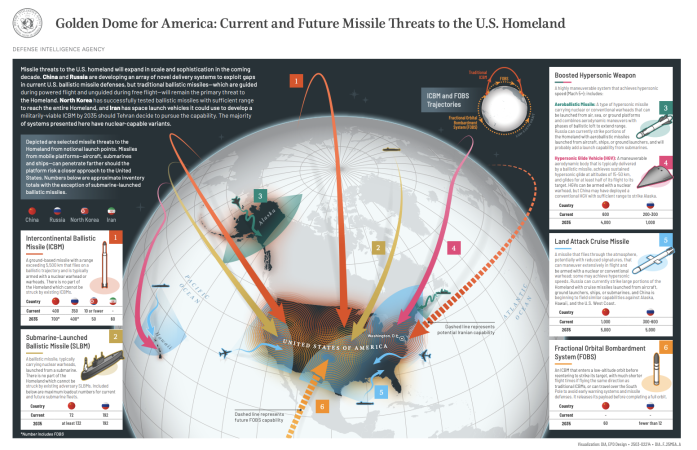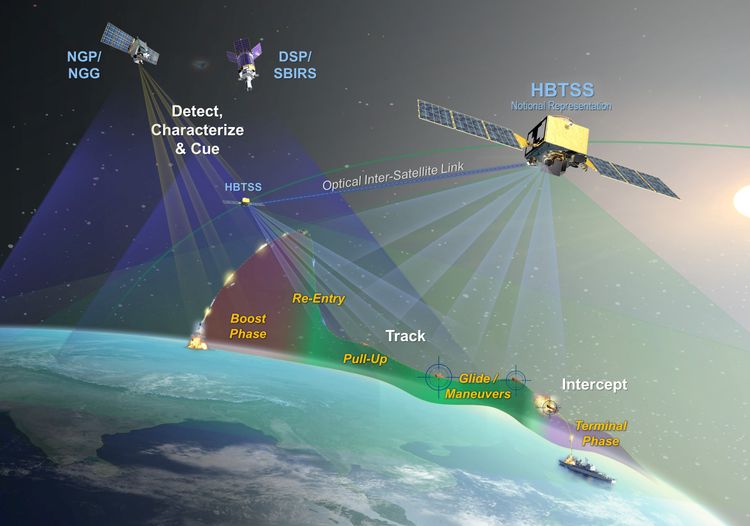The Pentagon is developing space-based sensors that can distinguish missile threats from clutter as a key part of the Trump administration’s Golden Dome missile defense initiative.
“We’re working on prototyping space sensor capabilities, in particular, Discriminating Space Sensor(DSS) to help improve ballistic missile defense in the future,” said Lt. Gen. Heath Collins, who heads the Missile Defense Agency, at a May 13 Senate Armed Services Committee hearing. “We will prototype it, and the Space Force will operationalize it.”
Cold War-era systems like the Defense Support Program and the Space-Based Infrared System (SBIRS) have existed for decades, but these launch-detection systems sometimes struggle to discriminate between real targets, decoys, and debris. The new DSS aims to distinguish real warheads from everything else to enable interceptors to defeat missiles in mid-flight.
An MDA spokesperson told Air & Space Forces Magazine the agency wants to launch a prototype satellite by 2029.
The DSS will complement the Hypersonic Ballistic Tracking Space Sensors (HBTSS) constellation. A Joint effort between MDA and the Space Force, the first two of these satellites were launched last February. HBTSS is designed to spot and track hypersonic threats, while DSS will zero in on the more predictable ballistic threats.
HBTSS satellites completed a demonstration test in March, in which the Navy destroyer USS Pinckney tracked a hypersonic-like target and simulated an intercept with an SM-6 missile; during the test, HBTSS satellites tracked the target accurately and relayed data quickly for interceptor operations.
“So far we have proven out the timeliness, latency, that of the fire control loop with those systems, as well as the sensitivity of those systems to close the loop,” said Collins, adding that the agency plans to continue to make “algorithm updates” to improve performance.
“All along, we’ve worked in parallel with the Space Force and Space Development Agency,” said Collins. “They now have our HBTSS-like requirements as part of their proliferated warfighting space architecture. In the tranches to come in the following years, they will solely be building up an operational hypersonic tracking layer for us.”
The Defense Intelligence Agency released an analysis May 13, warning that China, which already “may have deployed a conventional Hypersonic Glide Vehicle (HGV) with sufficient range to strike Alaska,” is building a stockpile of hypersonic weapons that could number 4,000 by 2035.

Yet as steerable hypersonic weapons arrive, conventional ballistic missiles will remain the primary threat to the United States from both China and Russia. Both possess missiles that can strike the U.S. homeland. Moscow can also reach much of the continental United States with cruise missiles, and China is fielding similar capabilities in range of Alaska, Hawaii, and the U.S. West Coast. DIA predicts that both Beijing and Moscow will each have some 5,000 cruise missiles in 10 years.
Golden Dome aims to block such threats. Proposed in President Trump’s inaugural address, the dome initiative has some bipartisan support, with the House Armed Services Committee last month voting to support a $25 billion investment for the project in a pending fiscal 2025 defense package. Concerns over the development timeline and overall cost, which could run into the trillions of dollars, remain as details at this stage are scant.


